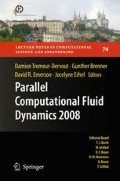Abstract
Computational Fluid Dynamics (CFD) has become an important tool for aerodynamics by the improvements of computer performance and CFD algorithm itself. However, the computational time of CFD continues to increase, while progress of computer has been made. One of the reasons is considered that application of CFD has become more complex. For example, CFD is employed to estimate aerodynamics performance for a complex shaped object such as formula one car (Fig. 1) Concerning complex shape, however, the problem of grid generation still remains. It requires so much time and labor. To overcome the problem in meshing for complex-shaped object, we have already proposed an algorithm [3]. The algorithm consists of two approaches. One is Immersed Boundary method [6], and the other is Building-Cube Method (BCM) [4]. The basic idea of Immersed Boundary method is applied to cells in the vicinity of solid boundary, and Cartesian grid method is performed for other cells. These approaches have several advantages except for solution convergence. In this paper, Implicit Residual Smoothing (IRS) [2] is proposed for improvements of solution convergence.
Access this chapter
Tax calculation will be finalised at checkout
Purchases are for personal use only
Preview
Unable to display preview. Download preview PDF.
References
P. H. Cook, M. A. McDonald, and M. C. P. Firmin. Airfoil rae2822-pressure distributions, and boundary layer and wake measurements. Experimental Data Base for Computer Program Assessment, AGARD-AR-138, 1979.
A. Jameson. The evolution of computational methods in aerodynamics. Journal of Applied Mechanics Review, 50(2):1052–1070, 1983.
T. Kamatsuchi. Turbulent flow simulation around complex geometries with cartesian grid method. SIAM J. Sci. Stat. Comput, 13(2):631–644, 2007.
K. Nakahashi and L. S. Kim. Building-cube method for large-scale, high resolution flow computations. AIAA Paper, 2004-0423, 2004.
S. Obayashi and G. P. Guruswamy. Convergence acceleration of a navier-stokes solver for efficient static aeroelastic computations. AIAA Journal, 33(6):1134–1141, 1995.
C. S. Peskin. Flow patterns around heart valves: A numerical method. Journal of Computational Physics, 10(2):252–271, 1972.
P. R. Spalart and S. R. Allmaras. A one-equation turbulence model for aerodynamic flows. AIAA Paper, 92-0439, 1992.
J. M. Weiss and W. A.Smith. Preconditioning applied to variable and constant density time-accurate flows on unstructured meshes. AIAA Journal, 33(11):2050–2057, 1995.
S. Yamamoto and H. Daiguji. Higher-order-accurate upwind schemes for solving the compressible euler and navier-stokes equations. Computer and Fluids, 22(2/3):259–270, 1993.
S. Yoon and A. Jameson. Lower-upper symmetric-gauss-seidel method for euler and navier-stokes equations. AIAA Journal, 26(9):1025–1026, 1998.
Author information
Authors and Affiliations
Corresponding author
Editor information
Editors and Affiliations
Rights and permissions
Copyright information
© 2010 Springer Berlin Heidelberg
About this paper
Cite this paper
Fukushige, T., Kamatsuchi, T., Arima, T., Fujino, S. (2010). Convergence Improvement Method for Computational Fluid Dynamics Using Building-Cube Method. In: Tromeur-Dervout, D., Brenner, G., Emerson, D., Erhel, J. (eds) Parallel Computational Fluid Dynamics 2008. Lecture Notes in Computational Science and Engineering, vol 74. Springer, Berlin, Heidelberg. https://doi.org/10.1007/978-3-642-14438-7_9
Download citation
DOI: https://doi.org/10.1007/978-3-642-14438-7_9
Published:
Publisher Name: Springer, Berlin, Heidelberg
Print ISBN: 978-3-642-14437-0
Online ISBN: 978-3-642-14438-7
eBook Packages: Mathematics and StatisticsMathematics and Statistics (R0)

